DiSC Styles and Stress

Key Takeaways
- D-style people feel stressed when they lack control. They’re great at tackling challenges head-on but may become impatient and harsh under pressure.
- i-style people feel stressed by rejection or social isolation. They excel at finding the positive in tough situations but may be disorganized and unreliable when stressed.
- S-style people experience stress from sudden changes and disrupted routines. They are good at playing the peacemaker in stressful times, but may also withdraw into passivity.
- C-style people fear being seen as incompetent. They’re great at staying objective under pressure but can become rigid and out of touch with others.
A 2025 survey revealed that 95 percent of people experience some level of work-related stress, with 36 percent reporting extreme levels.
People of different personality types experience stress differently. You'll notice this variance in many ways:
- the kinds of situations that stress them out
- the behaviors they display when stressed
- how they manage the stress
Remember that what is stressful for you may not be so for your coworkers, and vice versa.
For example, imagine that an already aggressive deadline moves even earlier. A D-style person may welcome this challenge with "bring-it-on" excitement, whereas someone with an S style might be overwhelmed.
Now say there is a new employee who is distraught and feeling lost. The S-style person thrives here and will take the lead. They will offer empathy, listen patiently, and figure out the problem. They will stick with the situation until the new employee has everything they need.
The D-style person would likely feel much more stress in this situation, fretting about wasted time.
Every person has a unique relationship with stress. This comes from their personality, life experiences, culture, and relationships. Here is some general advice about DiSC styles and stress.

DiSC D type stress management
D-style people prefer being in control, so they feel stressed when they lack that control. They may also feel challenged if you ask them to follow strict rules with no room for individual accomplishment.
D-type individuals feel stressed if you put them in a vulnerable position, or surround them with emotional or needy people.
You might notice your stressed-out D-style colleagues trying to work harder or put in more hours to prove themselves. Their mental strain might be showing itself through impatience and lack of sympathy.
What might be stressful to the D style?
People with D styles may find these things stressful:
- lack of control over a situation
- the appearance of being unprofessional or weak
- the possibility of being taken advantage of
- not getting definitive answers
- interruptions
- lack of independence or being able to take action
- falling into a boring, un-challenging routine
- dealing with the emotions of others
- anything that challenges their core belief of “I’m valuable if I’m on top”
What does the D style need during times of stress?
Keep these needs in mind when supporting your D-style colleges during stressful times:
- Progress: being able to get results quickly and efficiently
- Control: having influence over decisions that affect them and their success
- Justification: knowing how and why changes were made
D-style people want rewards in their surroundings. You can help them create an environment that supports their success and boosts their independence.
They can use help identifying when they are starting to railroad a decision or monopolize a conversation. Be direct. Remember to focus on the bigger picture and bottom line.
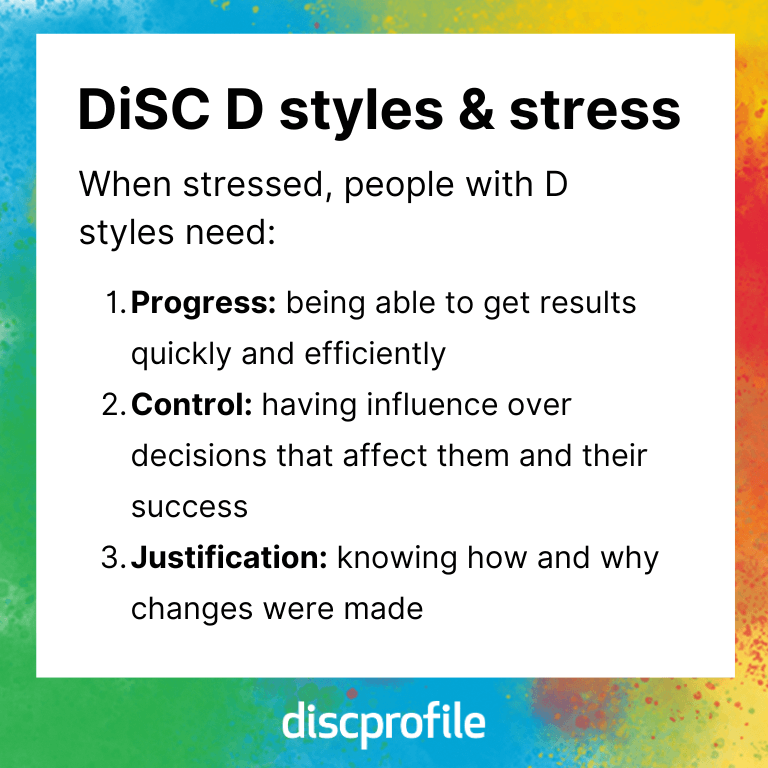
Stress management tips for D-style people
D-style individuals can manage stress by assessing what they can control and tackling challenges head-on.
- Identify what you can control, then let go of what you can’t. Focus your energies where you can have the most positive impact today or this week.
- Don’t try to do it all yourself. Your influence and long-term goals might be better served by finding ways to collaborate, delegate, and support.
- Give yourself a win. Find a challenging project you can finish fairly quickly. Give yourself a sense of accomplishment and progress.
- Adjust your schedule. Focus on high-impact tasks early in the day, and delegate less critical tasks.
- Stay active. All DiSC styles can benefit from physical activity when stressed, but D-style people often especially thrive on action.
- Channel competitive energy positively. Create mini-challenges for yourself, or engage in friendly competition with peers (make sure your peers want this!).
- Take intentional breaks. D-style people tend to push through stress, but it's essential to schedule time to recharge. Solo activities like hiking and reading can help you relax and refocus without the need for constant interaction.
DiSC i type stress management
People with i styles can become stressed by deadlines or repetitive tasks. They struggle with doing detailed analysis or not being able to express themselves.
A person with an i-type personality might show their stress through sadness, anger, lack of follow-through, or more disorganization than normal.
What might be stressful to the i style?
People with i styles may find these things stressful:
- few opportunities to be social or collaborative
- feeling rejected (with or without objective evidence)
- not getting the attention they crave
- routines feeling old, stale, or stifling
- a drop in the energy level around them
- being expected to control their impulses, especially creative or social ones
- pessimistic or distracted attitudes of others
- few opportunities for self-expression
- anything that challenges their core belief of “I’m valuable if I can attract people”
What does the i style need during times of stress?
You can support your i-style colleagues during stressful times by thinking of ways to help them meet these needs:
- Excitement: being part of energizing new opportunities
- Being heard: knowing that their opinions and feelings about the change(s) are heard
- Relationships: maintaining a connection with important people in their world
You can encourage the return of an i type’s natural upbeat attitude by allowing them to express themselves. Give them some positive attention. If you’re on a team, be sure they understand and share the team’s goals; then allow them to rally everyone.
Show enthusiasm for whatever they’re working on. If they have to do a boring task, make sure they get plenty of breaks. Let them decorate their workspace and encourage them to suggest ways to make the task more interesting. Even better, join them in the task and put on some good music.
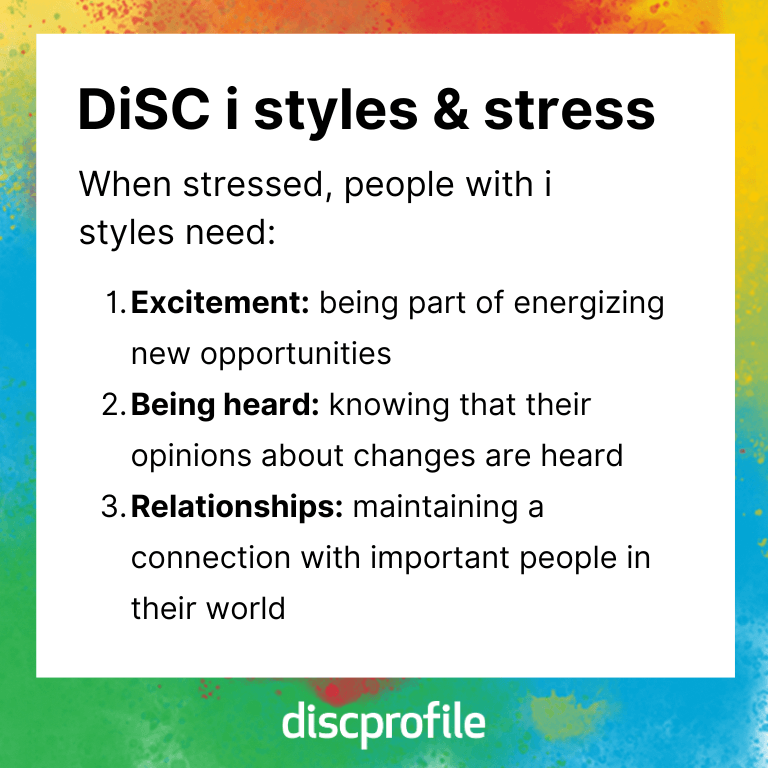
Stress management tips for i-style people
i-style folks can deal with stress by maintaining relationships and focusing on the positive.
- Add social interaction to your tasks. Say there's a new skill you need to learn for work that you're not excited about. Find a class where you can learn it alongside others, rather than slogging through tutorials at your desk alone. Or, you could set up a regular skill-sharing night with friends where you each share what you've learned since the last meeting.
- Balance work and play. Make sure you're leaving time for hobbies, outings, and other non-work-related activities to avoid burnout.
- Build variety into your routine by mixing up the order of tasks or taking creative breaks to recharge.
- Celebrate small wins with peers or friends to reinforce feelings of success. Give others a chance to recognize your work, or take time to appreciate your own achievements.
- Don’t take it personally if your introverted colleagues aren’t responding to stress in the same way. You may seek company and interaction, but others cope with stress by withdrawing.
- When you need to buckle down and get things done, try the Pomodoro Technique: Choose a task, set a timer for 25 minutes, and focus on only that task for those 25 minutes. When the timer goes off, take a five-minute break and put a checkmark on a piece of paper. Then, start the 25-minute timer again. Once you have four checkmarks, take a longer break during which you step away and do something like go for a walk outside.
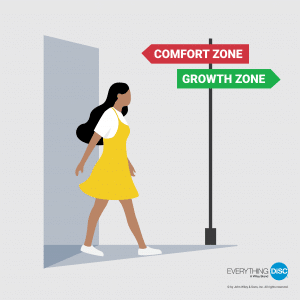
DiSC S type stress management
To stress out an S-style person, tell them they must confront someone else about their poor performance or disruptive attitude. Make them immediately change the operating procedure they’ve been following, providing no justification for the change and no time to practice. Next, have them convince someone they’ve never met that they support this new procedure.
S-style folks tend to get quiet and passive when experiencing a lot of stress. They can also become indecisive, inflexible, or too focused on details. The S-style person seeks out harmony and is attentive to the needs of others. This means you might not notice that they are feeling fear or neglecting their own needs.
What might be stressful to the S style?
People with S styles may find these things stressful:
- sudden change and disrupted routines
- uncertainties that make it difficult to plan ahead
- having to argue for their point of view
- seeing people struggle and not being able to help
- being in a conflict-filled environment
- feeling rushed
- having over-committed, taken on too much at work and home
- having to make decisions on their own without feedback from others
- anything that challenges their core belief of “I’m valuable if I am helping others”
What does the S style need during times of stress?
Support your S-style colleagues during stress by finding ways to help them meet these needs:
- Reassurance: knowing which things are under their control that they can make good choices around
- Harmony: freedom from tension and conflict
- Direction: knowing where they are headed and what is expected of them. Lack of clarity was listed as a top-3 stressor in a 2025 Wiley study, and this issue might be especially stressful for S-style people.
Encourage S-type personalities to speak up. Be sure that you are not mistaking their agreeable behaviors for a lack of passion, experience, or knowledge.
It can be tempting to try to take advantage of someone with this style. You can misread them and assume that they are aligned with your point of view or your actions. They might not be. Ask them. And if you value their answers, give them time to consider how they want to present their viewpoint.
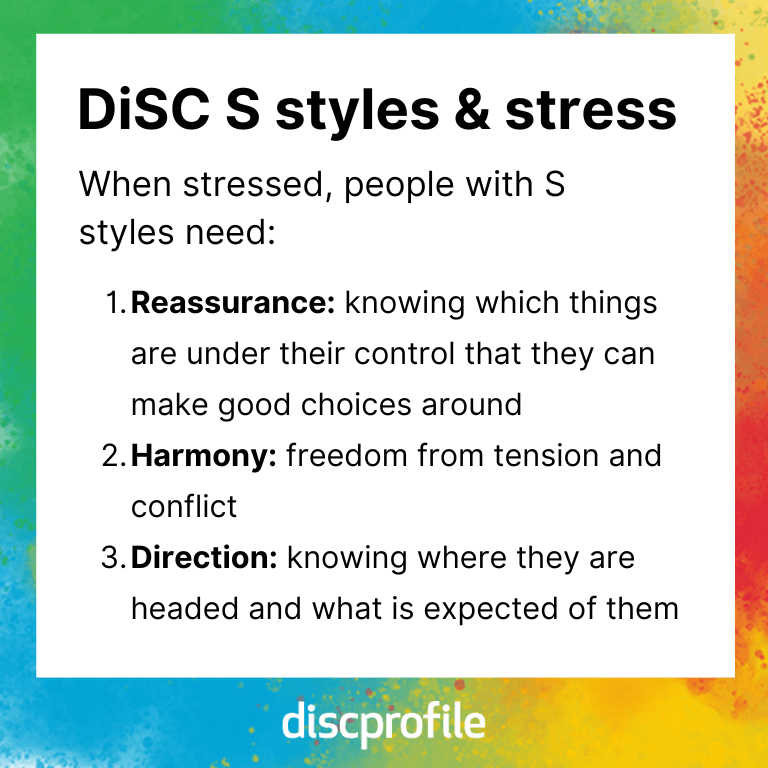
Stress management tips for S-style people
S-style folks can manage stress by setting boundaries and establishing routines.
- Work on building your comfort with both conflict and making mistakes—two things that are normal and often healthy.
- Make plans for staying connected to friends and family; don’t wait for it to happen naturally. This may mean putting regular events on your calendar reminding you to text, call, or write someone. Reaching out because it’s an item on your to-do list doesn’t make your connection with that person less genuine.
- Find ways to volunteer and give back to your community (if you haven’t already overcommitted to volunteer work). Doing good for someone else can often recharge an S-style person’s battery.
- If you have taken on too much, find a way to lighten your load. This may mean letting someone down for a while. Practice saying “no” to extra tasks when your to-do list is already full.
- You may be worried about bothering other people by asking for help. Consider this: being honest about your feelings can help others. It normalizes their own feelings of stress, and it gives them a chance to help someone they care about (you!).
- If you find it hard to speak up in meetings, send a note to your team. Share ideas to help everyone who wants to talk have a chance to do so.
- Concrete, project-based tasks are comforting, and it feels good to check them off your list. But that might mean you procrastinate on bigger-picture or more creative aspects of your work that also need your attention. Block out time that is only for brainstorming and creative thinking.
DiSC C type stress management
To stress out C styles, put them in a room with several emotional and erratic people. Or give them a poorly defined goal to reach with few resources and a short time frame. And tell them they’ll be graded. Or just ask them to learn a new skill in front of others.
You might appreciate how C styles are able to focus on the big picture during a crisis and make logical choices. Or you might notice them becoming more rigid and out of touch with others. They react to stress by overusing restraint and by relying on data and analysis to an even greater degree.
What might be stressful to the C style?
People with C styles may find these things stressful:
- Not having all the desired facts to make decisions
- Strong emotional displays
- Not knowing how best to respond to the needs of others
- Making well-considered plans and then having to change them
- Not being able to meet their high standards
- Working under time pressure
- Being unprepared
- Anything that challenges their core belief of “I’m valuable if I’m competent”
What does the C style need during times of stress?
Your C-style colleagues are not likely to admit they are struggling. Look for signs of stress and help them meet these needs:
- Competence: knowing that they can do their jobs well and maintain credibility
- Understanding: knowing the implications of the change(s) and maintaining their expertise
- Stability: having a sense of predictability and freedom from chaos
Be clear about expectations. Let them know how they will be judged.
If someone with a C style has done something wrong and becomes defensive, allow them time to run a self-diagnostic of the situation. They need to know how and why they screwed up (and they need to be able to decide if they agree that it was a screw-up).
Express confidence in their ability to learn from a mistake. Deflect their attention from the error, and move it toward how to make amends, fix it, or continue toward the goal. Assure them that you still see them as competent.
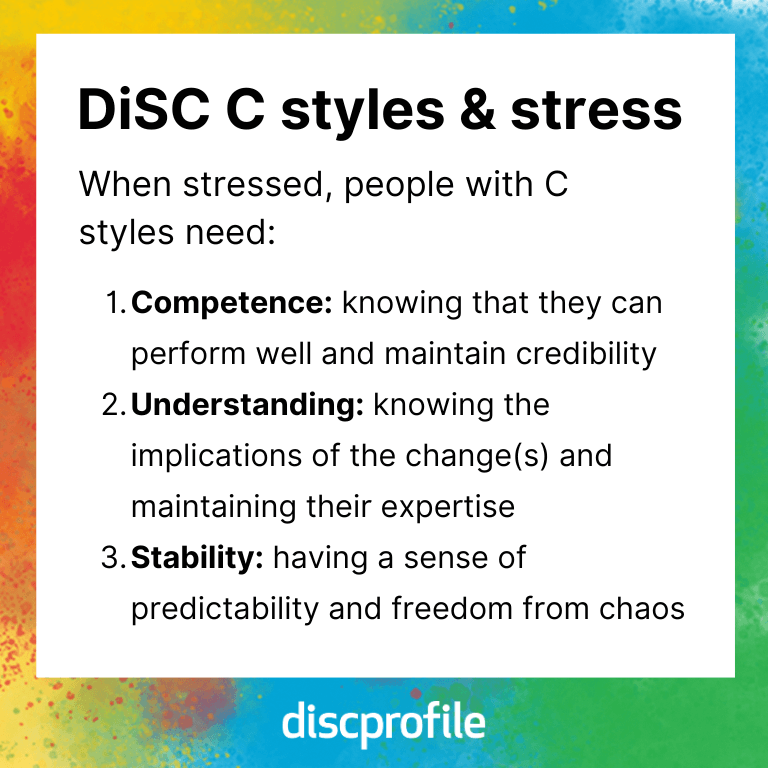
Stress management tips for C-style people
C-style individuals can manage stress by avoiding isolation and not being so hard on themselves.
- Maintain a structured environment. Assess what you can control, then make that realm well-organized. Develop systems and processes that make sense to you and help you focus.
- Focus on accuracy, not perfection. Sometimes you need to accept "good enough," as difficult as that can be for C styles. Learn to recognize when a task is done well enough, even if it’s not 100% perfect.
- Consider that there might not be an optimal answer or best choice. If you make a poor choice, that might be data for your next one.
- Collaborate selectively. Collaboration is valuable, but carve out time to work independently, which might be more comfortable for you.
- Don’t put off difficult conversions. Putting them off won’t make them easier. Do prepare the other person.
- Establish routines based on what you value. For example, if you value learning, take a regularly scheduled online course. If you value a relationship, schedule regular contact with that person. If you enjoy teaching, offer to demonstrate how to use an online platform, play a new game, or develop a skill.
- You don’t have to do it all. Build up your delegation skills. Set limits on workload and create realistic boundaries.
Using DiSC for stress management
Tailoring stress-relief techniques to suit each DiSC style helps in reducing burnout. It also promotes a greater sense of well-being and team cohesion. Everything DiSC® Workplace is a useful tool for individuals, teams, and managers to discover stressors and gain a common language for discussing stress management at work.
By understanding the strengths and stress triggers of each DiSC style, leaders and individuals can create better workplaces. When people feel supported in ways that resonate with their core tendencies, they are more likely to thrive both personally and professionally.
.png)
Posted 09/05/2018, Last Updated 02/26/2025







